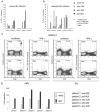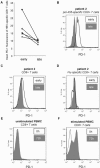Expression of the interleukin-7 receptor alpha chain (CD127) on virus-specific CD8+ T cells identifies functionally and phenotypically defined memory T cells during acute resolving hepatitis B virus infection
- PMID: 16537621
- PMCID: PMC1440406
- DOI: 10.1128/JVI.80.7.3532-3540.2006
Expression of the interleukin-7 receptor alpha chain (CD127) on virus-specific CD8+ T cells identifies functionally and phenotypically defined memory T cells during acute resolving hepatitis B virus infection
Abstract
Virus-specific CD8+ T cells play a central role in the outcome of several viral infections, including hepatitis B virus (HBV) infection. A key feature of virus-specific CD8+ T cells is the development of memory. The mechanisms resulting in the establishment of T-cell memory are still only poorly understood. It has been suggested that T-cell memory may depend on the survival of virus-specific CD8+ T cells in the contraction phase. Indeed, a population of effector cells that express high levels of the interleukin-7 receptor alpha chain (CD127) as the precursors of memory CD8+ T cells has recently been identified in mice. However, very little information is currently available about the kinetics of CD127 expression in an acute resolving viral infection in humans and its association with disease pathogenesis, viral load, and functional and phenotypical T-cell characteristics. To address these important issues, we analyzed the HBV-specific CD8+ T-cell response longitudinally in a cohort of six patients with acute HBV infection who spontaneously cleared the virus. We observed the emergence of CD127 expression on antigen-specific CD8+ memory T cells during the course of infection. Importantly, the up-regulation of CD127 correlated phenotypically with a loss of CD38 and PD-1 expression and acquisition of CCR7 expression: functionally with an enhanced proliferative capacity and clinically with the decline in serum alanine aminotransferase levels and viral clearance. These results suggest that the expression of CD127 is a marker for the development of functionally and phenotypically defined antigen-specific CD8+ memory T cells in cleared human viral infections.
Figures





References
-
- Appay, V., P. R. Dunbar, M. Callan, P. Klenerman, G. M. Gillespie, L. Papagno, G. S. Ogg, A. King, F. Lechner, C. A. Spina, S. Little, D. V. Havlir, D. D. Richman, N. Gruener, G. Pape, A. Waters, P. Easterbrook, M. Salio, V. Cerundolo, A. J. McMichael, and S. L. Rowland-Jones. 2002. Memory CD8+ T cells vary in differentiation phenotype in different persistent virus infections. Nat. Med. 8:379-385. - PubMed
-
- Appay, V., and S. L. Rowland-Jones. 2004. Lessons from the study of T-cell differentiation in persistent human virus infection. Semin. Immunol. 16:205-212. - PubMed
-
- Bachmann, M. F., P. Wolint, K. Schwarz, P. Jager, and A. Oxenius. 2005. Functional properties and lineage relationship of CD8+ T cell subsets identified by expression of IL-7 receptor α and CD62L. J. Immunol. 175:4686-4696. - PubMed
-
- Chemnitz, J. M., R. V. Parry, K. E. Nichols, C. H. June, and J. L. Riley. 2004. SHP-1 and SHP-2 associate with immunoreceptor tyrosine-based switch motif of programmed death 1 upon primary human T cell stimulation, but only receptor ligation prevents T cell activation. J. Immunol. 173:945-954. - PubMed
-
- Fuller, M. J., D. A. Hildeman, S. Sabbaj, D. E. Gaddis, A. E. Tebo, L. Shang, P. A. Goepfert, and A. J. Zajac. 2005. Cutting edge: emergence of CD127 high functionally competent memory T cells is compromised by high viral loads and inadequate T cell help. J. Immunol. 174:5926-5930. - PubMed
Publication types
MeSH terms
Substances
LinkOut - more resources
Full Text Sources
Other Literature Sources
Medical
Molecular Biology Databases
Research Materials

